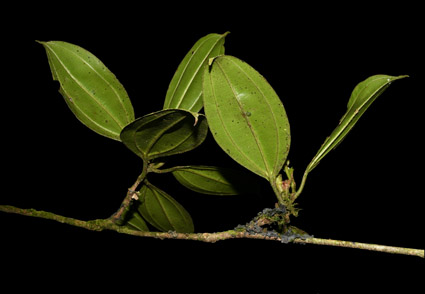Abstract
A new species of Blakea (Melastomataceae) from the department of Meta, Colombia is described and illustrated here, with comments on its etymology, distribution and habitat, phenology, conservation status and taxonomic affinities. Blakea cubarralensis sp. nov. is readily distinguished by its floral bracteoles that are longer than the calyx lobes, the outer pair ovate-elliptic with a long-acuminate apex and 3-nerved, the lobed calyx, the anther connective prolonged into a blunt knob and the ovary 12-locular. The new species is categorized as Endangered (EN) according to the IUCN Red List. This novelty highlights the importance of sub-andean forests and the need to conserve and increase botanical explorations in them.
References
- Almeda, F. (1990) New species and new combinations in Blakea and Topobea (Melastomataceae), with and historical perspective on generic limits in the tribe Blakeeae. Proceedings of the California Academy of Sciences 46 (14): 299–326.
- Almeda, F., Mendoza-Cifuentes, H., Penneys, D.S., Michelangeli, F.A. & Alvear, M. (2015) Melastomataceae. In: Bernal, R., Gradstein, S.R. & Celis, M. (Eds.) Catálogo de plantas y líquenes de Colombia. Instituto de Ciencias Naturales, Universidad Nacional de Colombia. Available from: http://catalogoplantasdecolombia.unal.edu.co (accessed: 15 April 2023).
- Almeda, F. & Penneys, D.S. (2018) Blakea echinata (Melastomataceae: Blakeeae): a new species from the Caribbean rainforest of Panama. Phytotaxa 372 (1): 104–110. https://doi.org/10.11646/phytotaxa.372.1.9
- Bachman, S., Moat, J., Hill, A., De La Torre, J. & Scott, B. (2011) Supporting Red List threat assessments with GeoCAT: Geospatial conservation assessment tool. ZooKeys 150: 117–126. https://doi.org/10.3897/zookeys.150.2109
- Beentje, H. (2010) The Kew Plant glossary: An illustrated dictionary of plant terms. Royal Botanic Gardens, Kew.
- Carvajal Rojas, L. & Ledesma, N. (2021) The Palmeras: A Natural Reserve, Cubarral, Colombia. Proceedings of the Florida State Horticultural Society 134.
- Don, D. (1823) An illustration of the natural family of plants called Melastomaceae. Memoirs of the Wernerian Natural History Society 4: 276–329.
- Gleason, H.A. (1933) Nine South American Melastomes. Phytologia 1 (1): 41–48.
- Hewson, H. (2019) Plant indumentum: A handbook of terminology. Australian Gov. Publ. Service.
- IUCN. (2012) IUCN Red List Categories and Criteria: Version 3.1 (Second Edition). Gland, Switzerland and Cambridge, UK.
- Judd, W.S., Majure, L.C., Michelangeli, F.A., Goldenberg, R., Almeda, F., Penneys, D.S. & Stone, R.D. (2022) Morphological Variability Within the Melastomataceae (Myrtales), Including a Discussion of the Associated Terminology. In: R. Goldenberg, Michelangeli, F.A. & Almeda, F. (Eds.) Systematics, Evolution, and Ecology of Melastomataceae. Springer Cham., pp. 45–85. https://doi.org/10.1007/978-3-030-99742-7_3
- Mendoza Cifuentes, H., Posada Herrera, J.M. & David, H. (2021) Nuevas propuestas nomenclaturales en Melastomataceae y adiciones de la familia al Catálogo de la Flora de Colombia. Revista de la Academia Colombiana de Ciencias Exactas, Físicas y Naturales 45 (177): 1154–1174. https://doi.org/10.18257/raccefyn.1448
- Penneys, D.S. & Almeda, F. (2022) An Overview of Pyxidantheae (Melastomataceae). In: R. Goldenberg, Michelangeli, F.A. & Almeda, F. (Eds.) Systematics, Evolution, and Ecology of Melastomataceae. Springer Cham., pp. 291–305. https://doi.org/10.1007/978-3-030-99742-7_13
- Penneys, D.S. & Judd, W.S. (2011) Phylogenetics and Morphology in the Blakeeae (Melastomataceae). International Journal of Plant Sciences 172 (1): 78–106. https://doi.org/10.1086/657284
- Penneys, D.S. & Judd, W.S. (2013) Combined Molecular and Morphological Phylogenetic Analyses of the Blakeeae (Melastomataceae). International Journal of Plant Sciences 174 (5): 802–817. https://doi.org/10.1086/670011
- Ruiz, H. & Pavón, J. (1830) Flora Peruviana, et Chilensis. Vol. 4. Madrid, España.
- Thiers, B. (2023) Index Herbariorum: a global directory of public herbaria and associated staff. New York Botanical Garden’s virtual herbarium. Available from: http://sweetgum.nybg.org/ih/ (accessed 10 May 2024)
- Ulloa Ulloa, C., Almeda, F., Goldenberg, R., Kadereit, G., Michelangeli, F.A., Penneys, D.S., Stone, R.D. & Veranso-Libalah, M.C. (2022) Melastomataceae: Global Diversity, Distribution, and Endemism. In: Goldenberg, R., Michelangeli, F.A. & Almeda, F. (Eds.) Systematics, Evolution, and Ecology of Melastomataceae. Springer Cham., pp. 3–28. https://doi.org/10.1007/978-3-030-99742-7_1
- Urrea, J., Mendoza-Cifuentes, H. & García, N. (2023) Novedades taxonómicas y sinopsis del género Blakea (Melastomataceae, Pyxidantheae) en la Cordillera Oriental, Colombia. Acta Botanica Mexicana 130. https://doi.org/10.21829/abm130.2023.2172
- Valoyes Cardozo, Z. & Morales-Puentes, M.E. (2011) Nuevos registros y redescubrimiento de dos especies de Blakea (Melastomataceae) en Chocó, Colombia. Revista Bioetnia 8 (2): 163–170. https://doi.org/10.51641/bioetnia.v8i2.43
- Wurdack, J.J. (1976) Atlas of Hairs for Neotropical Melastomataceae. Smithsonian Contributions to Botany 63: 1–80. https://doi.org/10.5479/si.0081024x.63


